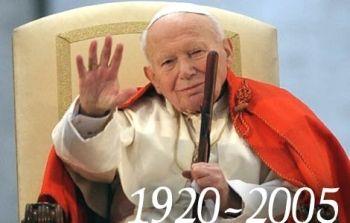By Ralph E. Stone
The Salem-News
May 1, 2011
http://www.salem-news.com/articles/may012011/pope-beatification-rs.php
 |
| Pope John Paul II, April 10, 2003. |
The beatification of John Paul II makes the Church seem more and more like a good old boys' club where connections and privilege count.
(SAN FRANCISCO) - Author's note: Some caveats before I begin. I am not a Roman Catholic and I am very skeptical of the whole concept of sainthood, the miracles in support thereof, and papal infallibility.
The beatification of the late Polish-born Pope John Paul II was held on Sunday. When I think of the late John Paul II, I remember his tepid response to child abuse by priests, showing more concern with the effect the scandal was having on the Church rather than the effect on the children. Sure priests betrayed their vows, but he showed little concern about betrayals of the trust that a child has for their priest.
And I remember the 1997 letter from the Vatican
I also remember Sinead O'Connor on Saturday Night Live when she tore a photo of Pope John Paul II
The number of pedophile priests and their victims are hard to come by as the Church has not been altogether forthcoming with information. Consider, however, that the number of pedophile priests in the Catholic Church in the U.S. is extrapolated to be as high as 10,969. The percentage of pedophile priests is 20 to 200 times higher than found in the secular population. By looking at the figures concerning other countries you can see the extent of the problem: 4,392 priests accused of pedophilia in the U.S.; 1,700 priests accused of sexual abuse on little children, orgies and use of drugs in Brazil; 107 priests and clergymen convicted in Australia of abuse with minors; 800 clergymen accused of more than 14,000 cases of abuses in Ireland. Plus, hundreds of cases in Holland, Poland, Croatia, France, England, and Mexico. Up to now, in the U.S., more than $3 billion has been paid in financial compensation. More than one billion for financial compensation has been asked by the survivors of Ireland's industrial schools. And it seems that every day there is a new accusation of abuse or a new court case filed against a pedophile priest. Most, if not all, of the allegations of pedophilia happened on Pope John Paul II's watch.
I recommend The Boys of St. Vincent, a 1992 film directed by John N. Smith for the National Film Board of Canada. It is a two part docudrama based on real events that took place at the Mount Cashel Orphanage in St. John's, Newfoundland, one of a number of child sexual abuse scandals in the Roman Catholic Church. This film was followed in 1993 by The Boys of St. Vincent: 15 Years Later when the various boys involved The Boys of St. Vincent are brought in to testify against the brothers.
There are about 10,000 Roman Catholic Saints. How does one become a Roman Catholic saint? Canonization, the process the Roman Catholic Church uses to name a saint, has only been used since the tenth century. For hundreds of years, starting with the first martyrs of the early Church, saints were chosen by public acclaim, which seems a more democratic way to recognize saints. Gradually, the bishops and finally the Vatican took over authority for approving saints.
In 1983, Pope John Paul II made sweeping changes in the canonization procedure. The process begins at least five years after the death of a Catholic whom people regard as holy. Usually, the local bishop investigates the candidate's life and writings for heroic virtue (or martyrdom) and orthodoxy of doctrine. Then a panel of theologians at the Vatican evaluates the candidate. After approval by the panel and cardinals of the Congregation for the Causes of Saints, the pope proclaims the candidate "venerable."
The next step, beatification, requires evidence of one miracle (except in the case of martyrs). Since miracles are considered proof that the person is in heaven and can intercede for us, the miracle must take place after the candidate's death and as a result of a specific petition to the candidate. (Pity the poor protestants who have no saints to intercede for them.) Pope John Paul's miracle concerns a 49-year-old French nun, Sister Marie Simon-Pierre, who was diagnosed with an aggressive form of Parkinson's disease in 2001 and whose order prayed to John Paul II after his death in 2005 for help. Didn't members of the order pray for her before John Paul's death? Who is to say that the prayer to John Paul II was the one heard by God and not the earlier, more direct ones?
As mentioned above, ordinarily permission to open an investigation is given five years after the death of the person being investigated. By rushing through the beatification of Pope John Paul II, his predecessor and friend, Pope Benedict has shown how silly the whole idea and process of 'making saints' is. The beatification of John Paul II makes the Church seem more and more like a good old boys' club where connections and privilege count.
In my opinion, whatever else Pope John Paul II accomplished during his papacy is completely overshadowed by the widespread abuse of children by priests and the initial Church coverup. Obviously, the Church disagrees with his beatification. What faith can anyone have in a Church that says it stands by the teachings of Jesus, yet violates his Biblical mandate stated in Mark 10:14: "Let the children come to me; do not try to stop them; for the kingdom of God belongs to such as these."
Contact: stonere@earthlink.net
Any original material on these pages is copyright © BishopAccountability.org 2004. Reproduce freely with attribution.